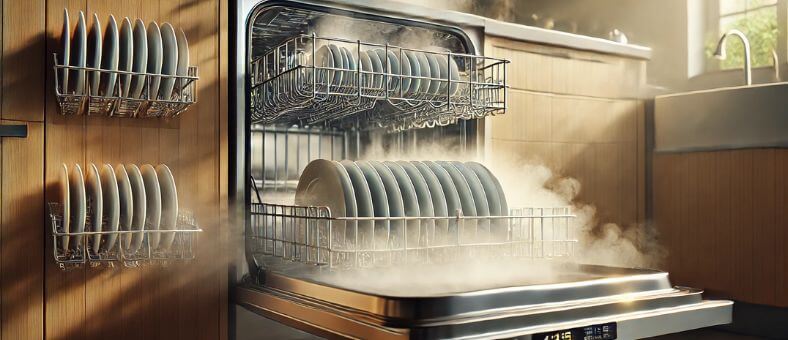Have you ever noticed lingering odors or unsatisfactory cleaning results from your dishwasher? The culprit might be a component many overlook: the dishwasher filter. Recognizing the signs of a dirty dishwasher filter is essential to diagnose and remedy the issue. Understanding the 6 Easy Steps to Clean Your Dishwasher Filter can drastically improve your appliance’s performance. This filter is pivotal in ensuring dishes come out sparkling and need regular attention. Its primary role is to trap food particles, prevent clogs, and ensure optimal dishwasher operation.
A clean dishwasher is crucial not just for pristine dishes but also for maintaining a fresh-smelling kitchen. You’re in the right spot if you’ve been pondering how to effectively cleanse your dishwasher filter. Let’s dive in, but first, you must know about the signs of a dirty dishwasher filter.
The Importance of Regular Cleaning
Did you know? 85% of dishwasher users report better dishwashing results after cleaning their filter regularly.
Table of Contents
Signs of a Dirty Dishwasher Filter
- Reduced Cleaning Efficiency: Dishes come out less than sparkling due to clogged filters and trapped food particles.
- Persistent Odors: Lingering foul smells often result from decaying food particles stuck in the filter.
- Standing Water: Water pooling at the bottom of your dishwasher may indicate a blocked filter affecting drainage.
- Visible Debris: Food bits or residue at the bottom suggest the filter isn’t trapping particles effectively.
- Noisy Operation: A struggling dishwasher working harder due to a clogged filter may produce a louder noise than usual.
- Residue on Dishes: Spots, streaks, or a filmy coating on dishes point to poor water flow caused by a dirty filter.
- Frequent Cycles: Rewashing dishes or running extra cycles often signals a filter problem.
- Physical Damage: Visible wear or cracks on the filter indicate it’s time for cleaning or replacement.
Step#1: Locating the Dishwasher Filter
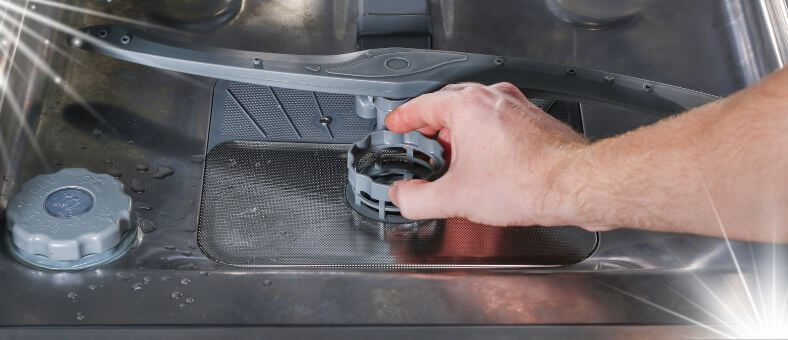
Start by identifying the location of the dishwasher filter. In most dishwashers, the filter is on the interior floor, beneath the lower rack. Depending on the dishwasher model, it can be a circular or cylindrical component. Refer to your dishwasher’s manual or manufacturer’s website to ensure you locate the filter accurately.
Step#2: Safely Detaching the Filter
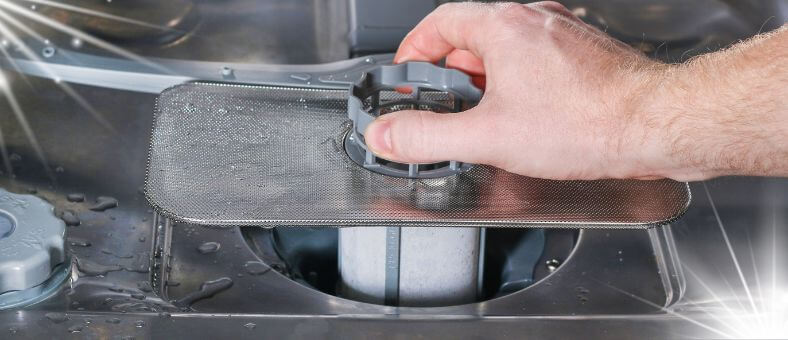
Before removing the filter, ensure the dishwasher is turned off and empty. Gently pull out the lower rack to access the filter. For circular filters, twist it counterclockwise, following the directional arrows until it unlocks. Lift it up to detach it from the dishwasher floor. If there is an additional flat filter below the cylindrical one, remove it as well.
Step #3: Thorough Cleaning of the Filter
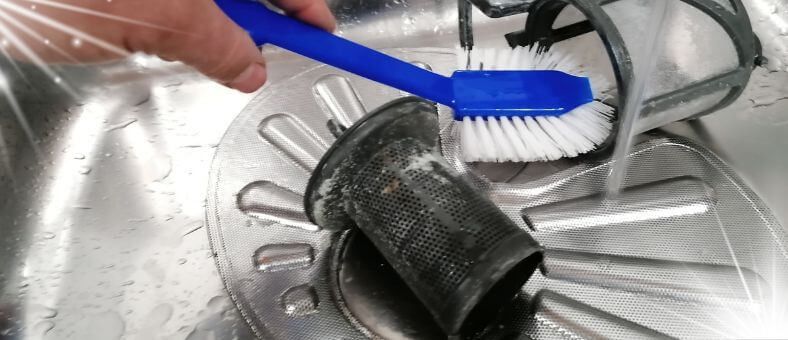
Prepare a cleaning solution by filling a sink or large bowl with hot water and adding a few drops of dishwashing liquid. Submerge the filter(s) in the solution and let them soak for a few minutes. Use a sponge, old toothbrush, or soft-bristled nylon brush to remove any trapped debris and residue on the filter. Pay close attention to hard-to-reach areas.
Step #4: Attention to the Dishwasher Tub
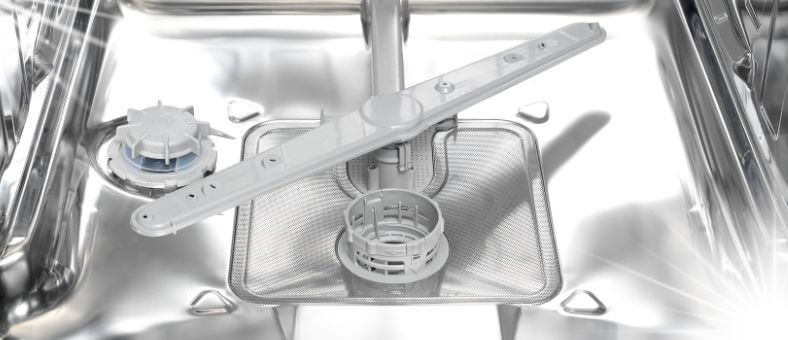
While the filter is soaking, take the opportunity to inspect and clean the dishwasher tub. Look for any food particles or debris that may have accumulated. Use a damp cloth or sponge to wipe down the interior surfaces, including the bottom of the dishwasher. Ensure that the tub is free from any residue before reinserting the filter.
Step #5: Proper Replacement of the Filter
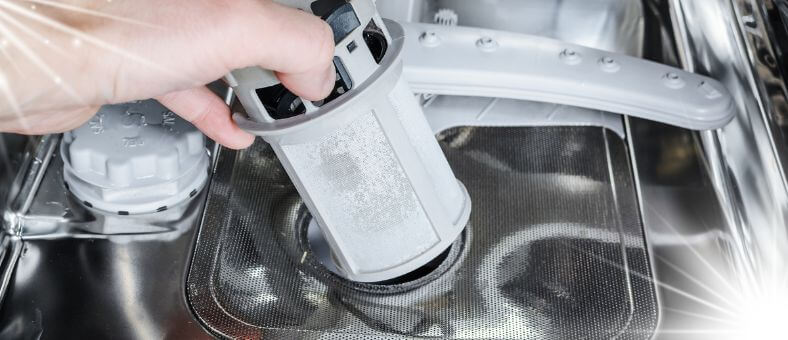
After thoroughly cleaning the filter and the dishwasher tub, it’s time to replace the filter. For circular filters, align the tabs or arrows on the filter with the corresponding slots on the dishwasher floor. Insert the filter and twist it clockwise to lock it securely in place. If there is a secondary flat filter, insert it first and then place the cylindrical filter on top.
Step #6: Final Touch: Cleaning the Filter Housing
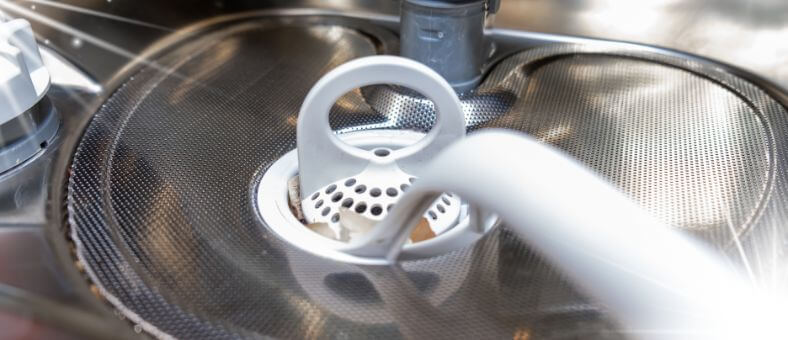
To complete the cleaning process, use a sponge or dishcloth dipped in hot soapy water to wipe down the opening where the filter was removed. By focusing on removing food particles from the filter and its housing, you ensure a deeper cleanse. This step not only eliminates grease build-up but also plays a pivotal role in maintaining the overall hygiene of your dishwasher.
Lingering Odors No More!
A whopping 72% of households noticed a significant reduction in unpleasant dishwasher smells once they started frequent filter cleanings.
Preventing Clogs in Your Dishwasher Filter
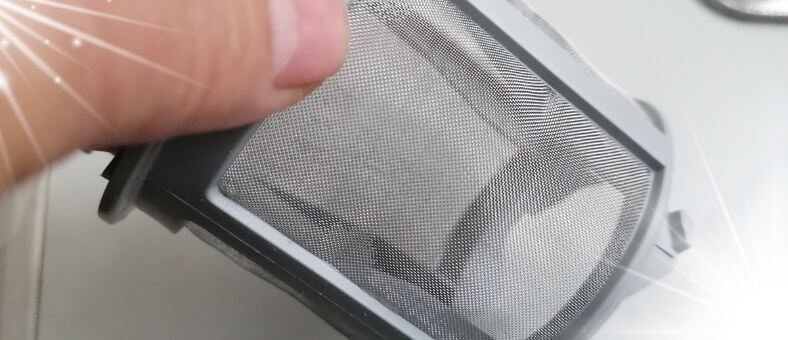
A clogged dishwasher filter can lead to various issues, including poor cleaning performance, unpleasant odors, and drainage problems. To keep your dishwasher filter free from clogs and ensure its optimal functionality, follow these practical tips:
Pre-Rinse Your Dishes
Before loading your dishes into the dishwasher, scrape off excess food particles and rinse them under running water. This helps prevent large food particles from entering the dishwasher and clogging the filter.
Use a Food Strainer
Consider using a food strainer or filter basket in your sink drain to catch larger food debris. This prevents them from entering the dishwasher and accumulating in the filter.
Avoid Excessive Grease and Oil
Be mindful of greasy or oily dishes. Wipe excess grease with a paper towel before placing them in the dishwasher. Excessive grease can solidify and clog the filter over time.
Check for Hard Water Deposits
Hard water minerals can accumulate in the dishwasher and clog the filter. Regularly check for any signs of mineral deposits, such as white or chalky residue. If you’ve ever wondered about the other effects of hard water on your appliance, you can learn more about Dishwasher Problems Caused by Hard Water. Use a dishwasher cleaner or vinegar to remove them.
Clean the Spray Arms
Inspect the dishwasher’s spray arms periodically. Clogs or debris in the spray arms can hinder the proper flow of water, leading to filter blockages. Remove any debris using a toothpick or small brush.
Avoid Overloading the Dishwasher
Overloading the dishwasher can restrict water circulation and increase the chances of debris getting trapped in the filter. Follow the manufacturer’s guidelines regarding load capacity for optimal performance. If you’re unsure about the best way to load your dishes, check out this guide on How to Load Your Dishwasher Properly for some helpful tips.
Use Quality Dishwasher Detergent
Use a high-quality dishwasher detergent formulated to dissolve food particles effectively. If you’re on the hunt for a top recommendation, check out What is the Best Dishwasher Detergent. Alternatively, if you’re leaning towards a more natural route, consider giving Homemade Dishwasher Detergent a try. Both choices can help minimize the buildup of residue in the dishwasher and filter.
Perform Regular Maintenance
Schedule regular maintenance for your dishwasher, including cleaning the filter, inspecting the spray arms, and checking for leaks or malfunctions. This proactive approach can prevent potential clogs and maintain the overall efficiency of your dishwasher.
Tips for a Clean, Efficient Dishwasher Filter
- Use a dishwasher filter cleaning solution or tablet for tough residue.
- Clean small crevices with a toothpick or brush.
- Check and clean clogged spray arms.
- Avoid placing non-dishwasher-safe items.
- Use baking soda or lemon juice for odors.
- Install a water softener or use additives for hard water.
- Consider a dishwasher with a self-cleaning filter.
- Monitor dishwasher performance for potential filter issues.
- Set reminders for regular filter maintenance.
Efficiency Matters!
Cleaning your dishwasher filter can boost its efficiency by up to 15%! That’s energy, time, and money saved in the long run.
Troubleshooting Common Dishwasher Filter Problems
- Due to food particles and debris, clogging is a common issue with dishwasher filters. Regularly clean the filter to remove any buildup.
- Leaks or damages in the filter can lead to water leakage and ineffective filtration. Replace a damaged filter promptly.
- If dishes are not getting cleaned, the filter may not work effectively. Clean or replace the filter to ensure optimal performance.
- Ensure the filter fits properly to prevent water leakage and inadequate filtration. Adjust or reinstall the filter if needed.
Final Thoughts on Easy Steps to Clean Your Dishwasher Filter
Eureka! Who would’ve thought that the road to a pristine dishwasher is paved with such simple steps? We’ve walked through the nooks and crannies of dishwasher maintenance, and it’s clear that a sparkling, efficient dishwasher lies in the heart of a clean filter. Here’s the real deal: To elevate your dishwashing game to unparalleled heights, consider investing in top-notch dishwasher tools and solutions. Why settle for less when perfection is within reach? Dive in, make the smart choice, and revel in the joy of spotless dishes, wash after wash. Your dishwasher deserves it, and so do you. Let’s embark on this sparkling journey together!
Home Warranty Protection for Dishwashers
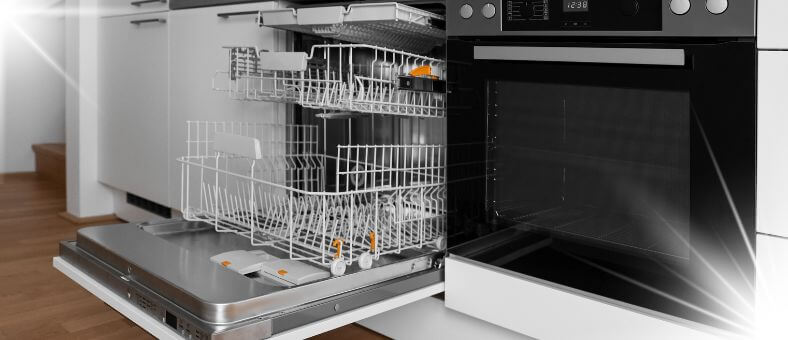
Are you worried about the unexpected breakdown of your dishwasher? Home Warranty Protection for Dishwashers can be a game-changer. This service contract covers the repair or replacement of major home appliances, including dishwashers, in the event of mechanical failures. In this guide, we’ll delve into the benefits of having a home warranty specifically for your dishwasher, how it operates, and key considerations when selecting a plan. For both homeowners and landlords, understanding this protection can be a financial lifesaver, helping you avoid unexpected repair bills and ensuring your appliance’s longevity. Dive in and uncover the advantages of a dedicated home warranty for your dishwasher, your pathway to peace of mind.
Not Just for Newbies!
Surprise! Home warranties aren’t limited to new dishwashers. Many plans cover older models, giving your trusty machine added protection.
What is Home Warranty Protection for Dishwashers?
Home Warranty Protection for Dishwashers offers homeowners coverage and peace of mind in the event of unexpected repairs or breakdowns. With this type of warranty, homeowners can enjoy financial protection and avoid the hassle of finding and hiring a repair technician on their own.
Coverage and Benefits of Dishwasher Warranty Plans
Dishwasher warranty plans provide coverage for various components and parts of the dishwasher, including the motor, pump, control panel, heating element, and more. Additionally, these plans may offer benefits such as 24/7 customer support, access to a network of qualified technicians, and the convenience of easy claims filing.
We will delve into the specific coverage and benefits you can expect from a dishwasher warranty plan.
Motor and Pump
The motor and pump are vital components of your dishwasher’s functioning. A warranty plan typically covers any mechanical failures or malfunctions in these parts, including repairs or replacements.
Control Panel
The control panel operates and regulates the dishwasher’s various settings. A warranty plan will typically cover issues with the control panel, such as faulty buttons, display malfunctions, or electrical failures.
Heating Element
The heating element is essential for the efficient drying and sanitization of your dishes. A warranty plan will cover any defects or malfunctions in the heating element, ensuring your dishwasher operates optimally.
Spray Arms
The spray arms distribute water evenly inside the dishwasher to effectively clean your dishes. A warranty plan may cover any issues with the spray arms, such as blockages, damage, or improper rotation.
Door Latch and Hinges
The door latch and hinges are critical for the secure and smooth operation of the dishwasher door. A warranty plan covers faulty or broken door latches, hinges, or related components.
Water Inlet Valve
The valve controls water flow into the dishwasher. A warranty plan may cover repairs or replacements of the water inlet valve if it fails to function correctly.
Drain Pump and Hose
The drain pump and hose remove wastewater from the dishwasher. A warranty plan will usually cover any drain pump or hose issues, such as clogs, leaks, or malfunctioning components.
In addition to specific coverage, dishwasher warranty plans offer several benefits to homeowners.
Qualified Technician Network
Warranty plans often provide access to a network of talented, licensed technicians specializing in dishwasher repairs. These technicians are skilled in diagnosing and resolving various dishwasher issues.
Easy Claims Filing
Dishwasher warranty plans typically have a streamlined claims filing process, making it convenient for you to report a problem and initiate the repair process. This helps expedite the resolution of your dishwasher issues.
Understanding the Claims Process for Dishwasher Repairs
When you encounter a problem with your dishwasher covered under warranty, it’s essential to understand the claims process. It can help streamline the repair process and minimize any inconvenience.
- Initiate the claims process by contacting the warranty provider and obtaining their contact information.
- Furnish details about the issue, including the model and serial number, problem description, and relevant documentation.
- Adhere to the instructions given by the warranty provider, such as submitting forms online or speaking with a representative.
- Work with the assigned service technician for assessment and repair, following their instructions and providing access to the appliance.
- Be patient as the warranty provider reviews and authorizes the repair, staying in touch for updates.
- Once authorized, the service technician will carry out the necessary repairs or arrange for a replacement, as per the warranty terms.
- Inspect the repaired or replaced dishwasher to ensure the issue is resolved. Contact the warranty provider if any concerns persist.
How to Choose the Right Home Warranty for Your Dishwasher
Selecting the proper home warranty for your dishwasher requires careful consideration. We will provide helpful tips and factors when choosing a warranty plan. From evaluating coverage options to comparing pricing and customer reviews, we will guide you through decision-making to ensure you select the best warranty for your dishwasher.
Assess Coverage Options
Evaluate the coverage options offered by different warranty providers. Look for plans that include dishwasher coverage and consider the extent of coverage for components and repairs.
Consider Cost and Pricing
Compare the cost of different warranty plans, including any deductibles or service fees. Consider the overall value for money and ensure the plan fits within your budget.
Read Terms and Conditions
Carefully review the terms and conditions of each warranty plan. Pay attention to coverage limitations, exclusions, and specific requirements or obligations.
Research Provider Reputation
Research the reputation and reliability of warranty providers. Read customer reviews and ratings to gauge customer satisfaction and service quality.
Renewing and Extending Your Dishwasher Warranty
Renewing and extending your dishwasher warranty offers numerous advantages that make it a worthwhile decision:
It ensures uninterrupted protection for your appliance, safeguarding against unexpected repair expenses. By extending the warranty, you can maintain coverage for potential future issues that may arise. This proactive approach provides peace of mind, knowing that your dishwasher is protected for an extended period.
Renewing or extending the warranty can lead to cost savings. Instead of bearing the entire burden of repair or replacement costs, warranty coverage can help alleviate the financial strain.
If your dishwasher is in good working condition, renewing or extending the warranty extends coverage into the appliance’s later years, offering added security against potential breakdowns.
Canceling or Transferring Your Dishwasher Warranty
To cancel your dishwasher warranty, follow the provider’s cancellation procedure and be aware of any fees or limitations. If you’re transferring coverage, check if it’s allowed and provide the new owner’s details to the warranty provider. Always review the terms and procedures to avoid coverage gaps.
At WashDryDazzle, our primary goal is to equip you with invaluable knowledge to simplify your day-to-day tasks; to explore more, check out our central hub of Dishwasher Guides.
Frequently Asked Questions (FAQs)
How often should I clean my dishwasher filter?
It is recommended to clean your dishwasher filter at least once a month. However, if you notice your dishes aren’t coming out clean or there is a foul odor, you may need to clean it more frequently.
Can I clean the dishwasher filter without removing it?
In most cases, it is necessary to remove the dishwasher filter for proper cleaning. Refer to your dishwasher’s manual or manufacturer’s instructions for the correct method to remove and clean the filter.
Can I use household cleaning products to clean the dishwasher filter?
It is recommended to use mild dishwashing liquid or specialized dishwasher cleaning products to clean the filter. Avoid using harsh chemicals or abrasive cleaners that may damage the filter.
Are there any specific tools or brushes I should use to clean the dishwasher filter?
A soft-bristled brush, old toothbrush, or a soft cloth can be used to clean the dishwasher filter. Avoid using sharp or metal tools that may cause damage.
Can I put the dishwasher filter in the dishwasher itself to clean it?
It is not recommended to clean the dishwasher filter by placing it in the dishwasher. Follow the manufacturer’s instructions on how to clean and maintain the filter properly.
How long does the warranty coverage typically last?
How long does the warranty coverage typically last?
Can I transfer my dishwasher warranty if I sell my home?
Some home warranty providers allow for the transfer of the dishwasher warranty to the new homeowner. This can be a valuable selling point when selling your home. Check the terms and conditions of your warranty plan or contact the provider for specific details.
Can a home warranty for dishwashers be renewed or extended?
Yes, many home warranty providers offer the option to renew or extend your dishwasher warranty. This allows you to continue enjoying the benefits of coverage for an extended period. Contact your warranty provider to inquire about the renewal or extension options available.
Keeping Your Dishwasher in Peak Condition
Ensuring your dishwasher remains clean and efficient is key to its performance and longevity. We’ve compiled useful tips and guides on our website to assist you in this endeavor. These resources are designed to help you maintain your dishwasher in excellent condition:
- The Easiest Way to Clean a Dishwasher
- How to Fix a Dishwasher: Troubleshooting and Repair
- How to Load Your Dishwasher Properly
- Choosing the Right Dishwasher Size: A Guide to Finding the Perfect Fit
- How to Clean a Smelly Dishwasher: 5 Simple Steps to Cleanliness
- Dishwasher Problems Caused by Hard Water and How to Fix Them
Whether you’re a first-time dishwasher owner or aiming to master your skills, our guide is your go-to resource. It offers detailed instructions, expert tips, and solutions to frequent dishwasher concerns. Start your journey to dishwasher expertise with us!





